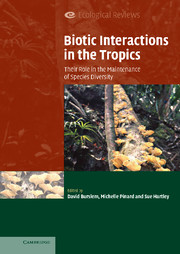Book contents
- Frontmatter
- Contents
- List of contributors
- Preface
- PART I Plant–plant interactions
- 1 Plant–plant interactions in tropical forests
- 2 Resource capture and use by tropical forest tree seedlings and their consequences for competition
- 3 Role of life-history trade-offs in the equalization and differentiation of tropical tree species
- 4 Neighbourhood effects on sapling growth and survival in a neotropical forest and the ecological-equivalence hypothesis
- 5 Ecological drift in niche-structured communities: neutral pattern does not imply neutral process
- PART II Plant–microbe interactions
- PART III Plant–animal interactions
- PART IV Biotic interactions in human-dominated landscapes
- Index
4 - Neighbourhood effects on sapling growth and survival in a neotropical forest and the ecological-equivalence hypothesis
Published online by Cambridge University Press: 25 August 2009
- Frontmatter
- Contents
- List of contributors
- Preface
- PART I Plant–plant interactions
- 1 Plant–plant interactions in tropical forests
- 2 Resource capture and use by tropical forest tree seedlings and their consequences for competition
- 3 Role of life-history trade-offs in the equalization and differentiation of tropical tree species
- 4 Neighbourhood effects on sapling growth and survival in a neotropical forest and the ecological-equivalence hypothesis
- 5 Ecological drift in niche-structured communities: neutral pattern does not imply neutral process
- PART II Plant–microbe interactions
- PART III Plant–animal interactions
- PART IV Biotic interactions in human-dominated landscapes
- Index
Summary
Introduction
In 1980 S. P. Hubbell and R. B. Foster began a long-term, large-scale study of tropical forest dynamics on Barro Colorado Island (BCI), Panama. The objective of the study was to test competing hypotheses about the maintenance of high tree species richness in the BCI forest, and in tropical moist forests more generally. Hubbell and Foster established a 50-ha permanent plot on the summit plateau of BCI, within which all free-standing woody plants with a stem diameter at breast height (DBH) of a centimetre or larger were tagged, measured, mapped and identified by 1982. Subsequent complete censuses of the BCI plot have been conducted from 1985 to 2000 at 5-year intervals. In setting up the BCI plot, Hubbell and Foster (1983) reasoned that whatever diversity-maintaining mechanisms were important, they would have to operate in a spatially dependent manner in communities of sessile plants such as the BCI tree community, which meant that the trees had to be mapped. A decade earlier, Janzen (1970) and Connell (1971) had independently proposed a spatially explicit ‘enemies hypothesis’, now known as the Janzen–Connell hypothesis. They hypothesized that host-specific seed and seedling predators were responsible for maintaining tropical tree diversity by causing dependence on density and frequency (rare species advantage), through an interaction between seed dispersal and density-dependent seed predation.
In 1980, there were essentially just two principal tropical forest diversity theories to test: the enemies hypothesis and its variants, and the ‘intermediate disturbance’ hypothesis (Connell 1977) and its variants that invoked a role for disturbances associated with opening, growth and closure of light gaps (e.g. Ricklefs 1978; Hartshorn 1978; Orians 1982; Denslow 1987).
- Type
- Chapter
- Information
- Biotic Interactions in the TropicsTheir Role in the Maintenance of Species Diversity, pp. 89 - 106Publisher: Cambridge University PressPrint publication year: 2005
- 18
- Cited by

